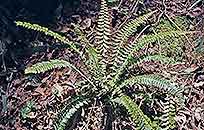Asplenium lunulatum Sw.
Synonyms |
Asplenium erectum Bory ex Willd. var. lunulatum (Sw.) Sim. |
|---|---|
Common name |
|
Description |
Rhizome erect to procumbent; scales up to 5 mm long, dark brown, lanceolate, margin entire. Fronds proliferous, tufted, erect to arching. Stipe up to 8 cm, matt brown, glabrous. Lamina 15-35 cm × 2-3.5 cm, pinnate, linear-lanceolate in outline. Pinnae hairless, oblong-rombic to falcate, base asymmetric, apex bluntly acute to obtuse, margins crenate. Sori 5-12 per pinnae, linear-lunate, 2-3 mm long, indusium entire. |
Notes | Differs from similar species by having gemmae on the frond tips and 5-12 sori per pinnae. Beentje, H.J.(2008, F.T.E.A.) remarks that "much of the East African material has been named as A. lunulatum from the 1930s onwards, but that taxon is restricted to Southern Africa". |
Derivation | lunulatum: crescent-shaped, referring to the sori of this fern. |
Habitat | Deeply shaded areas in evergreen riverine forest. |
Distribution worldwide |
|
Distribution in Africa |
Angola, Equatorial Guinea (incl. Bioko), Kenya, Malawi, Mozambique, South Africa, Swaziland, Tanzania , Uganda, Zimbabwe. |
Growth form |
Lithophytic, terrestrial. |
Literature |
|
